- Home
- Bill Bryson
Icons of England Page 12
Icons of England Read online
Page 12
DOWN MEMORY LANE
Miles Kington
on the family historian
SOMETIMES YOU CAN STILL see him, as dusk approaches, trudging along a country lane with the tools of his ancient trade dangling round him. He’ll have his bags of notebooks, his laptop computer in its neat waterproof case, and condensed county guides and parish registers, sometimes reduced to the abstracted wisdom of a CD-ROM.
He is, of course, the family historian, driven by his quest for arcane knowledge and by the compulsion to explore his own family history. He is not always a welcome figure. Sometimes remote householders will peer out through their curtained windows and hastily draw the drapes shut as they see him come along the lane, pulling one of those trolleys used by fishermen, to transport all that genealogical knowledge. More often, clergymen with lone churches in their care, full of irreplaceable books of deaths, births and marriages, will spot him coming and shiver. They know that once the family historian is ensconced in a church, he may be there for days or weeks. Or even months.
usually, there is just one family historian to each family. Nobody knows why, but each family seems to produce just the one member who acquires the urge to chart the furthest nooks and crannies of his own family tree. The rest of the family, if they ever had the incentive to follow the thin lines of descendants and forebears, are now quite happy to leave it to him.
It is nearly always a ‘him’. Very rarely does the family historian turn out to be a woman. Women are interested in people as people, not as strange names on a document. The gene that turns men into trainspotters, or into car experts, or into founts of knowledge about the personnel of jazz groups, must also be the one responsible for transforming them into family historians.
And so he comes to build up the map of the family. The family historian is very good at asking the little questions (such as ‘When Uncle Jack went off to make his fortune in Australia, is there any clue that he ever came back again?’ and ‘Who is this little bloke who keeps cropping up in family photos between 1920 and 1935 – his name is always crossed out so heavily that we don’t know who he is?’), but not so good at asking the big questions (such as ‘What on earth am I asking all these stupid little questions for?’).
I feel that being a family historian is an ancient craft, and that most of the old and grand families of England would have had their own archivist to keep the family tree in order. He might well have turned up as a character in a P. G. Wodehouse novel.
‘I say,’ said Cousin Augustus, ‘who’s that queer cove wandering around in the library, wearing a moustache that wouldn’t look out of place in the shellfish section of a fishmongers?’
‘Oh,’ said Aunt Mildred, ‘that’s young Wesley Snape. Your uncle has hired him to come and sort the family out.’
‘Sort the family out? What’s wrong with the family?’
‘There’s a whole lot of cousins missing in New Zealand in about 1890’ said Aunt Mildred.
‘Good God’ said Cousin Augustus. ‘Mass murder, was it?’
‘No,’ said Aunt Mildred. ‘Missing page in the family chronicle. Your uncle wants them all brought back and identified …’
But, of course, family historians do not turn up in modern novels. A novelist makes things up, and that would be anathema to a family historian. The noblest thing a family historian can do is go on lugging his family documents around with him, through the back lanes of old England, dragging back from obscurity characters that nobody ever knew existed in the first place.
EARTH PILGRIM
Satish Kumar
on Dartmoor
MY LIFE IS AN unending pilgrimage – I have no destination. Touching the earth – being connected to the soil, being mindful of every step – is how I practise eco-spirituality. Walking in the wild is my meditation. Walking in nature is my prayer, my peace and my solitude. Breathing, I inhale the air, which sustains me and connects me to all life.
Dartmoor is my temple and my church – a glorious cathedral of nature – that is millions of years old. It was formed by the powers of geological time and the generosity of nature. I come here for the breath of fresh air, the smell of the wet grass, the coolness of water and the purity of rocks.
I often make my pilgrimage to Wistman’s Wood, high up on the eastern moor. It’s an ancient oak grove that Druids made their place of worship thousands of years ago the – name Wistman’s Wood means ‘Wise man’s Wood’. The trees here hold firm to the earth to show us the resilience of life at high altitude, six hundred metres above sea level on the windy moors. They grow through massive slabs of granite. Local myths and legends speak of ‘nature spirits’ inhabiting these woods. When everything looks dry and dormant, lichen and moss thrive. Life is vibrant here. One species of lichen that lives in this wood can be found nowhere else on earth. It is exquisite, a vital link in the interconnectedness of all living things.
These woods are sparse now. Once, much of the moor was covered in oak. Now there are only remnants of the ancient forest – the wood’s aura of light and shade. It is a place of mystery, memory and meaning, and I feel at one with this primeval paradise. I find these trees loving, compassionate, still, unambitious and enlightened. In eternal meditation they give pleasure to a pilgrim, shade to a deer, berries to a bird, beauty to their surroundings, health to their neighbours, branches for fire and leaves to the soil. They ask nothing in return, in total harmony with the wind and the rain. The trees are my mantra, my poem and my prayer. Through them, I learn about unconditional love and generosity.
Mistletoe – a sacred plant – grows high on the trees when everything else is dormant. It is a celestial gift, the marvel of life in the darkness of winter. There is a symbiosis between the thrush and this plant. The mistle thrush’s song signals love as a biological imperative. Give the gift of kisses under mistletoe and your love will be eternal.
The Buddha would sit under a tree for hours in his renowned posture, touching the earth with the fingertips of his right hand. This symbolizes reverence for the earth and recognition that everything – our body, our knowledge and wisdom – comes from and returns to the earth. Someone once asked the Buddha from whom he learnt the virtue of forgiveness. The Buddha pointed towards the earth. That became his famous posture and gesture.
The oak wood below, lightning above and thunder all around, are part of the great mystery of nature. All the science, philosophy and poetry of the world put together cannot explain the ultimate meaning of existence. And I am happy to live with this mystery.
WRITING STILES
David Lodge
on stiles
THERE IS NO OBJECT more emblematic of rural England than the stile. Although I suppose other countries have them, they are especially characteristic of the English countryside, with its patchwork of fields bounded and protected by hedgerows and fences. But, of course, a stile is more than a utilitarian device for passing from one field to another. There are no urban stiles and to me, a child who first encountered country life during the Second World War as a displaced Londoner, stiles were novel and amusing structures, such as one might find in a playground. For adults, too, they have many uses: one may sit on them, stand on them, lean on them, use them for flirtation and courtship, conversation or confrontation. Symbolically, they are liminal objects, marking a threshold – the passage from one state to another. The classic English novelists were well aware of these possibilities. In Jane Eyre, for instance, the heroine first encounters Mr Rochester while sitting on a stile, where she has paused in the middle of a winter walk:
I sat down on a stile which led thence into a field. Gathering my mantle about me, and sheltering my hands in my muff, I did not feel the cold, though it froze keenly; as was attested by a sheet of ice covering the causeway …
Along comes Mr Rochester on his horse, which slips on the ice, throwing its rider to the ground. Jane helps him up and, leaning on her, he hobbles over to the stile and sits down. In the conversation that follows, he identifies her as the g
overness who has come to look after his ward. She helps him remount, and goes on to complete her errand, musing on the incident:
It was an incident of no moment, no romance, no interest in a sense; yet it marked with change one single hour of a monotonous life.
In fact, it has momentous consequences. It is Jane’s unflustered helpfulness in their first encounter which leads Rochester to fall in love with her, by imprinting her on his consciousness as his rescuer in need, just as she will be at the end of the story.
In the Victorian age, when women were swathed in clothing from head to foot, the act of negotiating a stile – and thus showing an ankle or a flash of petticoat to accompanying males – was full of possibilities for coquetry and gallantry. There is a delightful example in The Pickwick Papers. Mr Pickwick and his companions, walking across the fields to Dingley Dell for the Christmas celebrations, meet Mr Wardle and his daughter, Emily, accompanied by a bevy of young ladies. Introductions take place without formality:
In two minutes thereafter, Mr Pickwick was joking with the young ladies who wouldn’t come over the stile while he looked – or who, having pretty feet and unexceptionable ankles, preferred standing on the top rail for five minutes or so, declaring that they were too frightened to move. It is worthy of remark, too, that Mr Snodgrass offered Emily far more assistance than the absolute terrors of the stile (though it was full three feet high and had only a couple of stepping stones) would seem to require; while one black-eyed young lady in a very nice little pair of boots with fur round the top, was observed to scream very loudly, when Mr Winkle offered to help her over.
The most striking use of a stile, however, must be in Hardy’s Tess of the D’Urbervilles. When Tess, who has been seduced by Alec D’Urberville and is with child, is walking sadly back to her home village, she is overtaken by an artisan, carrying a pot of red paint. It is a Sunday morning. ‘All the week I work for the glory of man,’ he says, ‘and on Sunday for the glory of God … I have a little to do here at this stile.’ He stops, dips his brush in the paint pot, and …
… began painting large square letters on the middle board of the three composing the stile, placing a comma after each word, as if to give pause while that word was driven well home to the reader’s heart – ‘Thy, Damnation, Slumbereth, Not.’
Against the peaceful landscape … these staring vermilion words shone forth … Some people might have cried ‘Alas poor theology’ at the hideous defacement … But the words entered Tess with accusatory horror. It was as if this man had known her recent history; yet he was a total stranger.
The English countryside had a better class of vandal in those days.
BLUEBELL PICNICS
Gabby Logan
on Kew Gardens
I AM A CITY girl born in Leeds, raised in Leeds for a while and then on to Coventry, with a year in vancouver in the middle. The wonderful thing about being a child in most cities in the UK is that glorious countryside is never far away, not some intangible thing you can only read about in books. So although my farmer husband teased me about being a ‘townie’ when we met, I was quick to point out that I had been privileged enough to live on the doorstep of some of this country’s most beautiful landscapes: the Yorkshire Dales and the Cotswolds for two. In short, I may not have been adept at milking a cow but I knew good countryside when I saw it.
We now live in London, well, technically it’s Surrey, but we are five minutes’ walk from the Tube and two minutes’ walk from the Lion Gate entrance to Kew Gardens. To me that sentence sums up what it is to have the best of both worlds. I realize how lucky I am, and it’s my love of Kew I would like to share with you. I did wrestle with Richmond Park for a while, but discounted it because it’s more than three minutes from my front door.
I write this in September, a particularly exciting time of the year in Kew Gardens. The trees are starting to turn and in about three weeks there will be a day when the sun is in the corner of the sky looking like it doesn’t really want to bother coming out for a while, and it will cast a red light on the canopy of trees, so even the grass will look like an orange shade of green. The coaches and buses parked outside the Gardens with their Cardiff, Carlisle and Cornwall phone numbers on the side are testament to the joyous sight that Kew is in September; people will drive for hours to take in the experience.
There is one afternoon in particular I remember, when the children and I went collecting fallen conkers, and then we acted out scenes from The Wizard of Oz. It was the most natural thing in the world to do. Now, Kew Gardens is quite strict, no bikes, no scooters and no balls, but as long as you respect the plants and the trees, you can pretend to be the Tin Man or Dorothy all day long. Sit and think, walk and talk, learn and discover or play; just don’t try getting a scooter past those men in bottle-green uniforms at the entrance.
In the summer we took the Scottish cousins, who still live on a farm, for a picnic in a secluded corner of the Gardens. We didn’t see another face for an hour, and this was the height of the school holidays. The spot we had chosen was like something from a Lewis Carroll novel; we played hide and seek for hours in meadow grass with wild flowers around us.
Sometime in spring we’ll wander through the Gardens, we might be on our way home from school, and the carpet of purple crocuses will be out and we’ll all stand and stare in amazement at their beauty, while equally impressed tourists take pictures and video the scene because they may never get back to Kew.
Sure, Kew Gardens is known for its Lilac Garden and its Azalea Garden and its Japanese Gardens, and of course the Orangery and the Temperate House are very impressive. While I love all of these, I think I am happiest in the slightly more rugged conservation area, where the bluebells pop up in random fashion and the crowds tend not to go.
HIDDEN DEPTHS
Richard Mabey
on marshland
AT A CASUAL GLANCE, it seems the very negation of landscape. Nothing blocks the view to the horizon. There are no elevations, no shadows and no secret glades. The ground seems to have been scoured into a rumpled, homogeneous plain.
But marshland is more subtle than that. Think of it, for a moment, as a landscape whose contours are under the ground – as an inverted habitat, riddled with concavities. Then imagine it turned upside down. Now the prospect is alive with mounds and reticulations. Glacial hollows and human peat pits swell like prehistoric barrows. Dykes are three-dimensional fences. Peat layers appear and disappear in complex laminations.
Now turn it upright again. Think of the whole surface of the marsh as an outgrowth of this damp labyrinth. Resist the pull of the horizon and shorten your focus a little. The homogeneity vanishes. There are dark sedges, livid bog mosses and lustrous mist-green patches of reed. There are grass tussocks, scrubby tumps, pools and inscrutable ribbons of vegetation. And, closing your focus still further, you realize that this apparently bland and static view is in constant motion. Marshes – mosaics of thin verticals – are animated by the wind like no other landscape.
Now think of the birds that coast above marshlands as dowsers of this complex geometry of wetland and wind. Ducks explode into the air, manifesting patches of water that, to the watcher, are quite invisible. Marsh harriers tack across the fens, rising and falling as if they were riding invisible currents in the air – pockets of low pressure, tiny thermals generated by the minute shifts from water to grass to reed. Once, in Suffolk, I watched a hobby riding the subtle troughs in a reedbed like a surfer. It was catching dragonflies, and as it soared up to eat them, the chitin from the chewed-off wings fell back into the reed like tinsel. The whole vocabulary of the marsh is about this intimacy of movement: rustling, gliding, quaking, shimmering.
Nothing, however, animates marshland more than the water that created it. When the rains come (the winter floodtime), water finds its way back into the shallowest dips and into every inch-deep depression, remaking the landscape it formed ten millennia ago. And the shapes it makes seem amorphous and unbiddable. It slinks about
the surface of land like a Chinese whisper, full of possibilities, taking new form as it goes – joining field puddle with reed pool, with streamlet, with river.
Marshlands are the stage for fast-moving dramas of the great principles that govern ecosystems: change, continuity and connectivity. Water is an excellent communicator and forms a conduit for reed seeds and migrating eels, between ancient habits and new beginnings. Sometimes, when I walk on a marsh, efflorescences of water spread round my feet, and yards, maybe miles, further on I have the feeling that I’m squeezing water out on to some slumbering aquatic growths. Marshes may momentarily look inert and vacuous, but in reality they are agile, adaptive and inclusive. They are about living in the present and going with the flow.
A GUARDIAN OF BEAUTY
Fiona MacCarthy
on William Morris’s Kelmscott
KELMSCOTT MANOR IS A gabled grey stone house in the flat meadowlands between Faringdon and Lechlade. It stands at the furthest end of a small village, where a farm track transforms itself into the towpath of the river Thames. William Morris, the poet and designer who lived there from 1871 to his death in 1896, described Kelmscott as ‘a beautiful and strangely naíf house’. To him it had an almost mystic quality of Englishness, the unselfconscious sense of craftsmanship and total visual rightness, which inspired some of Morris’s most marvellous design work and sustained him through a turbulent, courageous personal life.

 Notes from a Small Island
Notes from a Small Island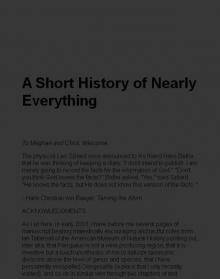 A Short History of Nearly Everything
A Short History of Nearly Everything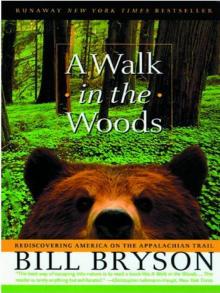 A Walk in the Woods
A Walk in the Woods I'm a Stranger Here Myself
I'm a Stranger Here Myself The Mother Tongue
The Mother Tongue Shakespeare
Shakespeare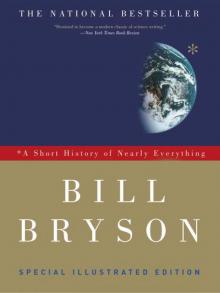 A Short History of Nearly Everything: Special Illustrated Edition
A Short History of Nearly Everything: Special Illustrated Edition The Best American Travel Writing 2016
The Best American Travel Writing 2016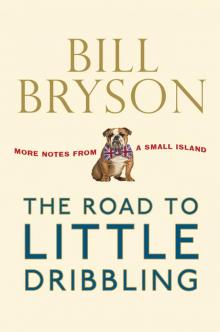 The Road to Little Dribbling
The Road to Little Dribbling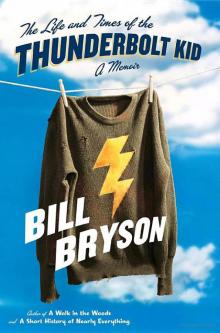 The Life And Times Of The Thunderbolt Kid: A Memoir (v5.0)
The Life And Times Of The Thunderbolt Kid: A Memoir (v5.0) Made In America
Made In America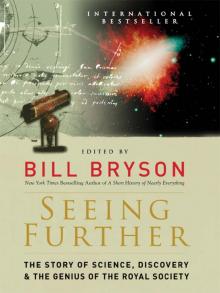 Seeing Further
Seeing Further Shakespeare: The World as Stage
Shakespeare: The World as Stage The Life and Times of the Thunderbolt Kid
The Life and Times of the Thunderbolt Kid At Home
At Home Bryson's Dictionary For Writers And Editors (v5.0)
Bryson's Dictionary For Writers And Editors (v5.0) Neither Here Nor There
Neither Here Nor There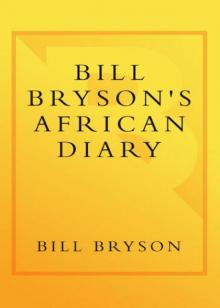 Bill Bryson's African Diary
Bill Bryson's African Diary